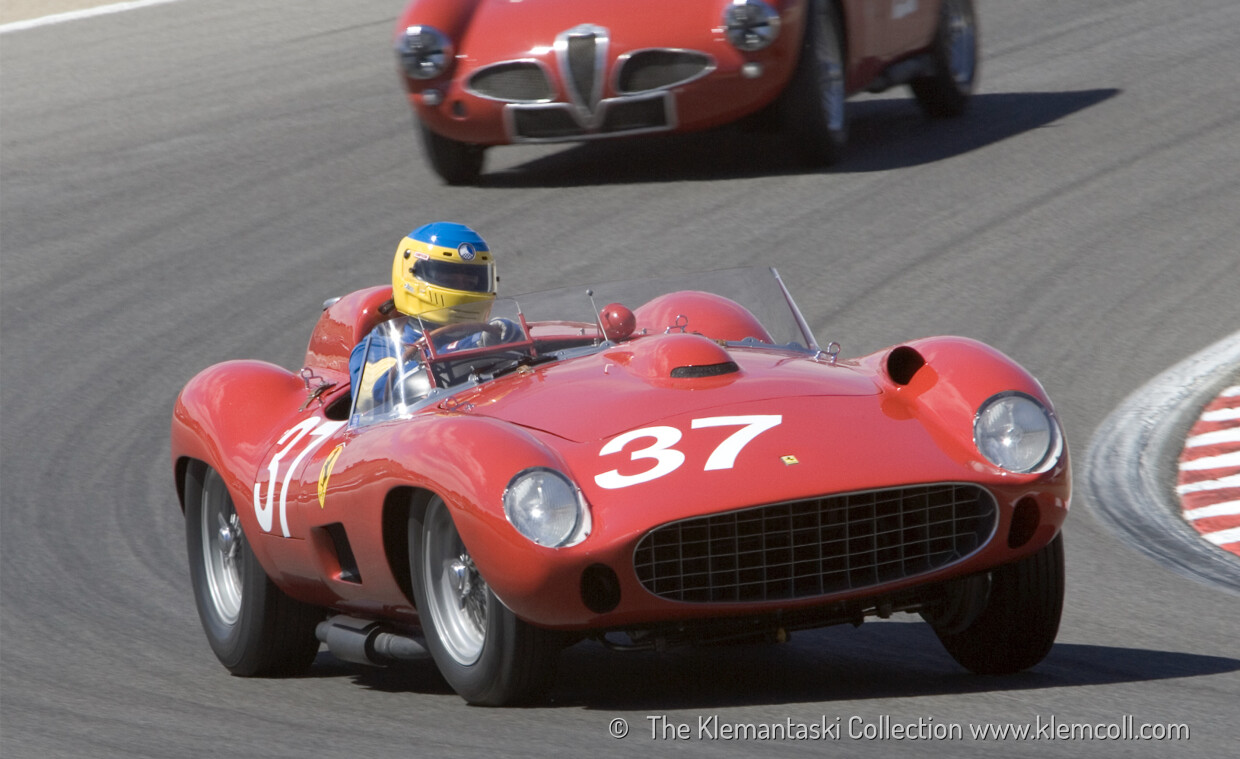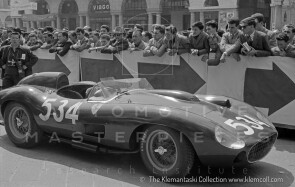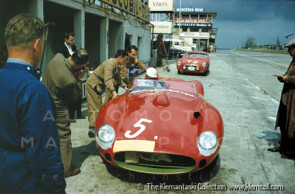
1957 Ferrari 335 S
ON/OFF
Why am I an Automotive Masterpiece?
H. Works cars
Scuderia Ferrari (IT)
L. Limited edition cars
no. 4 manufactured, 3rd built
From the 1947 125 Sport to the 1973 312 Prototype, Ferrari sports and prototype cars have claimed more victories than any other manufacturer. The 335 S was Ferrari’s ultimate weapon between 1957 and 1958. This sports racing car was a direct response to a formidable competitor: the Maserati 450S, which was challenging the 315 S and 290 MM. After the 1957 Sebring 12 Hours, an evolution of the 315 S was presented: the 335 S. This car featured the V12 engine, enlarged from 3.8-liters to a 4-liters displacement, reaching a power of 390 hp at 7400 rpm; the top speed was in excess of 300 Kph. Excluding the increased bore and stroke, the engine was the same front longitudinal 60° V12, entirely made of light alloy. This unit was designed by Vittorio Jano for sports car racing. Jano joined Ferrari in 1955, bringing with him designs for the Formula One Lancia D50, from which some technical ideas were derived. His design team included Vittorio Bellentani, Alberto Massimino, and Andrea Fraschetti. Jano’s team was tasked with designing a family of engines to replace Lampredi's inline-4s, known from the Ferrari Monza line. Introduced in 1956, the new unit combined elements of both Colombo and Lampredi engines with new features. All variants used dry sump lubrication and almost all had twin spark with four coils and DOHC. These engines were responsible for winning many international titles for Ferrari and were used in models such as the 290 MM, 290 S, 315 S, 312 S, 412 MI, and 412 S. The 335 S employed the "Tipo 141". This engine had DOHC, was fed by six Weber carburetors, had twin-spark ignition with four distributors, and used a multi-disc clutch for a four-speed gearbox. The tubular steel frame featured independent front suspension and a De Dion rear axle. The brakes were drum-type all around. The “barchetta” body was crafted by Scaglietti in aluminum and was very similar to that of the 315 S. We are aware of four cars that were definitely built: chassis no. 0646, 0674, 0700, and 0764. The first two were 315 S models later converted to 335 S specs; the fourth was assembled later on request of Luigi Chinetti. The 335 S made its World Championship debut in the third round of the season, the tragic 1957 Mille Miglia, with two examples (alongside two 315 S): one was entrusted to Peter Collins, and the other to Alfonso De Portago, who replaced the feverish Luigi Musso at the last moment. A terrible accident, caused by a tire failure, ended his race near Guidizzolo when he was in third position. The disaster claimed the lives of the driver, his co-driver Edmond Nelson, and nine spectators. The ensuing controversy ended the Mille Miglia and other road speed races on Italian soil. The 335 S was, however, a car difficult to beat: the prototype participated in the 24 Hours of Le Mans, setting the fastest lap at over 192 km/h on average, and its successes from intense official participation in championship races, added to the Mille Miglia victory by a 315 S and the win in the Buenos Aires 1000 Km by a 290 MM, earned Ferrari the 1957 Constructors’ World Title, the fourth it had won. The change in regulations for the World Championship to a 3-liter engine limit, a reaction to the Mille Miglia crash and earlier tragedies, rendered the 335 S ineligible for the 1958 season onwards, and Ferrari replaced the model with its 250 TR. The 335 S models were sold to private teams in the United States, including the fourth example produced, to compete in automotive races there. One of them participated in these races with the NART. Finally, it won the 1958 Cuban Grand Prix driven by Stirling Moss. Today, the Ferrari 335 S is one of the most highly valued classic sports cars.
The Ferrari 335 S with chassis no. 0700 was built in time for a racing debut in the 1957 Mille Miglia, where it participated as a works car for the Scuderia Ferrari, alongside its unlucky twin, the chassis no. 0646 of De Portago. Ferrari also entered two 315 S: chassis no. 0684, overall winner with Piero Taruffi, and chassis no. 0674. The 335 S chassis no. 0700 was entrusted to Peter Collins and Louis Klemantaski. The former was a young driver of great talent, known for his chivalry, while his co-driver had a double task, since he was the photographer said to have invented the art of motor racing photography and thus was the author of many spectacular onboard shots from the cockpit of the Ferrari in this race. The car was identified by racing number 534 and test plate “Prova MO 36,” previously used by the Ferrari 250 Mille Miglia participant in the 1953 edition with number 625. The actress Louise Cordier, wife of Peter Collins, waved the Brescia flag to start her husband. The extraordinary power offered by the new engine allowed Collins to set an impressive pace: the car was the protagonist of an absolute speed record, even beating the Mercedes-Benz 300 SLR driven by Stirling Moss in 1955, passing through Siena after 6h47’48” at an average speed of 161.992 kph (the previous record, achieved by Moss on this leg, was of 6h51’16” at 160,625 kph). Unfortunately, the transmission failure ended its race in Parma. Due to De Portago's crash, only chassis no. 0700, in the hands of Peter Collins and Olivier Gendebien, was entered in the next round at the Nürburgring 1000km, ranking second overall. Le Mans participation, on the contrary, was unlucky: the engine had failed in practice, it was rebuilt overnight and failed again after one lap leading the race, with Collins setting the fastest lap at an hourly average of 192 kph. Collins and Phil Hill obtained another second place at the Sverige Grand Prix, with Mike Hawthorn and Luigi Musso finishing fourth in sister car 0674. The 1957 calendar was packed: ten days later, chassis no. 0700, in the hands of Olivier Gendebien, finished third at Spa in the Grand Prix du R.A.C.B. But its most important success had yet to come at the Gran Premio Internacional de Venezuela: pontoon fenders for better brake cooling were fitted before the race; with Peter Collins and Phil Hill at the wheel, the car won that final round of the World Sports Car Championship, ensuring the Maranello house the World Title. At the end of November 1957, due to the new WSCC rules that excluded cars with an engine displacement above 3 liters, the car was sold to a private owner and sailed to North America. Before that, however, it had time to participate in the famous 1958 Gran Premio de Cuba, best remembered for the kidnapping of World Champion Juan Manuel Fangio by anti-government rebels led by Fidel Castro. Beginning in early December, up to 1960, the car competed mostly in US circuits with “big names” such as Phil Hill, Peter Collins, Richie Ginther, John Von Neumann, and Skip Hudson. Twenty years later, in 1980, chassis no. 0700 started its life as a classic in the Monterey Historic Races and participating in the main racing events and concours d’elegance. A separate discussion is warranted for the history of the engine, which, as often happens with racing cars, is disassembled and overhauled, if not replaced, between races. This history is reconstructed based on the Ferrari "engine book" (a listing commenced in 1957 that sets forth the use of each motor by its internal number during its Scuderia Ferrari history) and from the authoritative Peter Sachs: at an undefined moment after the 1957 Mille Miglia, the original engine was removed, and engine "numero interno" 141/1, previously fitted in Taruffi’s car for the 1957 Mille Miglia, was mounted on 0700. This 141/1 block was blown when being tested in 1959, so Richie Ginther obtained a replacement block from Ferrari, "numero interno" 142/1, and rebuilt a new engine, which is still mounted. From 1993 to 1995 the car had a complete restoration carried out and returned back to its original configuration. The Ferrari 335 S with chassis no. 0700 was featured in many themed books, such as Sandro Binelli’s Mille Miglia's Chassis - The Ultimate Opus Volume III.





